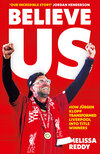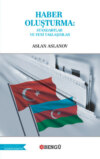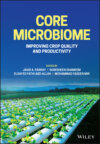Kitabı oku: «Believe Us»
BELIEVE US
How Jürgen Klopp transformed Liverpool into title winners
Melissa Reddy

Copyright
HarperNorth
111 Piccadilly
Manchester M1 2YH
A division of
HarperCollinsPublishers
1 London Bridge Street
London SE1 9GF
First published by HarperNorth in 2020
Copyright © Melissa Reddy 2020
Jacket design Steve Leard © HarperCollinsPublishers Ltd 2020
Cover photograph © Laurence Griffiths / POOL / AFP
Melissa Reddy asserts the moral right to be identified as the author of this work
A catalogue record for this book is available from the British Library
All rights reserved under International and Pan-American Copyright Conventions. By payment of the required fees, you have been granted the nonexclusive, non-transferable right to access and read the text of this e-book on screen. No part of this text may be reproduced, transmitted, downloaded, decompiled, reverse engineered, or stored in or introduced into any information storage retrieval system, in any form or by any means, whether electronic or mechanical, now known or hereinafter invented, without the express written permission of HarperCollins e-books.
Source ISBN: 9780008441951
Ebook Edition © November 2020 ISBN: 9780008441975
Version: 2020-11-24
Dedication
To the family, friends, colleagues and readers who believed in me.
This is a product of your support and encouragement.
Contents
Cover
Title Page
Copyright
Dedication
Premier League records Liverpool set or matched in 2019-2020
Jürgen Klopp’s records
1. A Club Divided
2. The Perfect Fit
3. A Change In Psychology
4. Method Over Money
5. Strengthening Off The Pitch
6. Reawakening The Fanbase
7. Lose Big To Win Big
8. Mentality Monsters
9. ‘500 Different Ways’ To Win
10. An Unprecedented Season
11. Leaving a Legacy
Picture Section
Acknowledgments
About the Publisher
PREMIER LEAGUE RECORDS LIVERPOOL SET OR MATCHED IN 2019-20

1. Liverpool notched up a 25-point lead at the top of the table this season, the biggest ever gap in English top-flight history.
2. Liverpool achieved 24 consecutive Premier League home wins in the 2019-2020 season, beating Man City’s record of 20, achieved between 2011 and 2012.
3. Claiming the title with seven matches to spare, Liverpool bettered Manchester United’s earliest title win in 2000/01, and Man City’s in 2017/18 – both won the league with five games to spare.
4. With their 1-0 win at Tottenham Hotspur on 11 January 2020, Liverpool set a record of 104 points over 38 consecutive Premier League matches, beating the 102 achieved by Manchester City and Chelsea, ending in 2018 and 2005 respectively. Liverpool extended their record to 110 points from 38 matches (W36 D2 L0) after beating West Ham United 3-2 in February 2020.
5. The 3-1 victory at Brighton & Hove Albion on 8 July was the Reds’ 30th this season, and they achieved that mark in a Premier League record of 34 matches.
6. With 61 points from their opening 21 matches, Liverpool won the most points ever accumulated at that stage in any of Europe’s top five leagues.
They went on to extend their record, winning their following six fixtures to rack up 79 points from their first 27 matches, before losing at Watford.
7. Liverpool’s 5-3 victory over Chelsea means they joined the Blues, Man Utd and Man City in winning 18 home matches in a Premier League season.
8. With the 3-1 victory in their final match at Newcastle United, Liverpool equalled the 32 victories claimed by Man City in 2017/18 and in 2018/19.
JÜRGEN KLOPP’S RECORDS
1. He reached 50 games in charge (in all competitions) in fewer days than any other Liverpool manager in history (217 days).
2. Klopp won 26 of his opening 50 league games — only Kenny Dalglish and Bill Shankly had a better win ratio.
3. He was unbeaten in his first 6 games in all competitions — the longest run without defeat since Bob Paisley and the third longest ever at the helm of Liverpool as a football league club.
4. Liverpool took 48 league games to reach the milestone of 100 goals under the German. It was achieved in the joint fewest number of top-flight matches, shared with Kenny Dalglish in 1986.
5. Klopp’s first goalscorer as a Reds manager was also a German — Emre Can against Rubin Kazan in the Europa League in October 2015.
6. He became the first Liverpool manager in history ever to win his first 3 derby matches in charge.
7. His team took 197 games to record 400 goals — faster than any other Reds boss.
8. Liverpool accumulated 300 league points in 146 games — the fewest games required by any Reds boss to reach the landmark.
9. Klopp oversaw more victories (92) in his first 150 league games in charge than any other Liverpool manager in history.
10. In 2019 he became the 5th German coach to win the European Cup/Champions League after Dettmar Cramer, Jupp Heynckes, Ottmar Hitzfeld and Udo Lattek
11. He was the 1st manager ever to take an English team to three European finals in his first three seasons of European competition.
12. Games Liverpool came from behind to win under Klopp (all competitions):
2015-16 6 of 22 (27%)
2016-17 5 of 11 (45%)
2017-18 3 of 14 (21%)
2018-19 5 of 8 (63%)
2019-20 6 of 11 (55%)
1
A Club Divided
‘We are still in the process of reversing the errors of previous regimes. It will not happen overnight.’
John W Henry
Football was no longer enjoyable, no longer an escape. Liverpool Football Club were once ‘the greatest team the world has ever seen’, but they hadn’t been for a while. For 25 years, the club watched as others — chiefly Manchester United — displaced them as the cream of England. The obsessive desire to win the league increasingly began to wear on players and staff, while disillusionment enveloped the fanbase. Near misses were followed by complete fall offs. There were triumphs in cup competitions and moments to eternally savour, but it was never enough. By September 2015, according to one long-serving employee at their Melwood training facility, Liverpool had been reduced to a ‘bunch of parts that didn’t feel like they belonged together. It was a miserable place to be. You knew the fans were fed up, you knew the players were drowning and there was bickering among the coaching staff. Nothing felt right’.
Liverpool had entered the month on the back of a demoralising 3–0 defeat by West Ham at Anfield, closely followed by a meek surrender and 3–1 defeat at Old Trafford to Manchester United. When manager Brendan Rodgers was quizzed about what was needed to change the team’s fortunes, his words were empty football-speak — ‘we need to want the ball more, we need to train harder’ — heightening the concerns of Liverpool’s owners.
Fenway Sports Group feared the stench of the 2014–15 season, which featured an abysmal non-performance in an FA Cup semi-final exit at the hands of Aston Villa and ended with a 6–1 humiliation at Stoke City, would linger well into the new campaign. They circled the October international break as the perfect window to shred the script and start afresh. With the exception of the Merseyside derby at Goodison Park, which was the final fixture before the hiatus, there was a list of very winnable games coming up — with four at home — for Rodgers to earn a stay of execution.
But Liverpool stumbled to a 1–1 draw at Bordeaux in the Europa League, before the same result at Anfield against Norwich City in the top flight later that week. Lowly Carlisle United came to Merseyside in the League Cup third round, with the hosts only scraping through on penalties after a torrid display. Toxicity filled the terraces at Anfield and it showed no signs of dissipating, especially not with supporters witnessing an unconvincing 3–2 win at home over Aston Villa, before yet another 1–1 draw in Europe, this time against little-known FC Sion.
While events on the pitch could be filed under certified disasters, soundtracked by boos from the Kop, decisive action was being taken in the boardroom. Liverpool’s chief executive at the time, Ian Ayre, made a call in mid-September that would alter the course of Liverpool’s history. He dialled Marc Kosicke, the agent of Jürgen Klopp, which led to a Skype call between the men. A face-to-face meeting between the German, who was on holiday having resigned from Borussia Dortmund four months earlier, and Liverpool’s hierarchy was pencilled in for 1 October 2015 in New York — the day of the club’s lethargic showing against FC Sion. But more on that later.
At Melwood, it was hard to escape the growing sense that Brendan Rodgers was on borrowed time. For some, it was surprise that the Northern Irishman was still in the job after the horror show at Stoke, which coincided with Steven Gerrard’s farewell game for Liverpool. Managers rarely climb out of the debris of such abominations unscathed, especially when large swathes of that 2014–15 season were best forgotten.
Supporters, too, were shocked. As Neil Atkinson, host of the award-winning fan media collective The Anfield Wrap wrote, ‘If Rodgers wasn’t a man fighting with himself at the start of 2014–15, he most definitely was by the end — and the thing about fighting with yourself is that you will always lose.
‘Liverpool lost. They lost and lost and lost. And then Stoke. Stoke was the final straw – how can you trust the man who oversees losing 6–1? For those who were there, Stoke would live long in the memory. What do you do about that? How do you rebuild those bridges? To have kept him beyond that point now feels tougher on him than on us.’
Deciding whether to stick or twist after the calamity at the Britannia Stadium was not straightforward. The owners had anticipated teething problems after the exhilarating but failed title tilt of 2013–14, which was followed by Luis Suarez’s departure to Barcelona. Despite the many controversies that surrounded him, Suarez had been the reference point and the fuel for Liverpool’s ambitions, and as Rodgers later reflected ‘the whole thing exploded’ when the Uruguayan moved on.
Having blocked his move to Arsenal the previous summer, Liverpool knew Suarez would exit in 2014 and pre-empted it by tying him to a new contract with a higher release clause of £75 million. It was still a snip for a player of his gifts, but Barça snapped him up for £10 million less than that fee after he was suspended from all football-related activity for four months for biting Italy defender Giorgio Chiellini during the World Cup.
Liverpool had a long time to prepare for life without their talisman but botched it. A process that started with priority target Alexis Sanchez joining Arsenal instead, was followed by next choice Loïc Rémy from Chelsea failing a medical, before the final pick was between an aged Samuel Eto’o and Mario Balotelli. Rodgers had publicly said he ‘categorically’ didn’t want the latter, but the maverick Italian was the player he got.
Balotelli was one of eight new first-team signings bought to the tune of £107.5 million to cushion the blow of losing Suarez. It was neither the wisest approach nor the best use of the money given to the manager, and other members of Liverpool’s transfer committee were, as one senior staffer put it, ‘not in the same book let alone on the same page’ in designing the squad.
With so many incomings, FSG understood there would be a reset of sorts. Adam Lallana was part of that mass recruitment drive during the summer transfer window of 2014, the midfielder costing £25 million from Southampton. He recalls how arduous his debut season was. ‘There were so many new players signed: a lot of different cultures, characters, languages and playing styles all coming together,’ says Lallana, who would go on to spend six years at Anfield before joining Brighton in July 2020.
‘It was a big adjustment for us, but also for the guys already at the club. We needed time to settle, but the expectation was huge. Liverpool lost Suarez, and Sturridge was injured, so the goals were effectively taken out of the team, yet there was still this pressure to go one better and win the league. It was a really difficult place to be in 2014–15 and things felt disjointed.
‘The way the season ended with that 6–1 defeat at Stoke City was really demoralising. We then lost Stevie [Gerrard] and Raheem [Sterling]. It only increased the pressure. It was intense. There was more fear than freedom and not a lot of confidence around.’
When FSG sat down with Rodgers to deconstruct such a pitiful season, they had underscored that it wasn’t just the listless performances that were a problem, but the anxious atmosphere around the club and lack of direction. While the owners appreciated the mitigating circumstances — reconfiguring the team post-Suarez, injuries, new signings needing to settle — they believed the manager hadn’t extracted the best from the squad. He was also underplaying his own hand by not fully integrating, trusting and maximising the strengths of those players he didn’t particularly want at the club.
FSG felt there weren’t enough ideas and diverse viewpoints being encouraged, with the manager’s coaching staff essentially only facilitating his plan rather than highlighting holes or offering suggestions.
There was an acceptance from Rodgers that a freshening up of the backroom team was needed to address the problems. His long-serving assistant Colin Pascoe was sacked and the contract of first-team coach Mike Marsh wasn’t renewed. Both decisions proved universally unpopular at the training complex, with players and staff outspoken about their views. Worse still, was the selection of Sean O’Driscoll as the new assistant manager.
‘When those changes happened, the dynamic completed shifted,’ says one employee who works closely with the backroom team. ‘It really didn’t sit well with anyone. Sean had a totally different opinion to Brendan and would openly counter his philosophy in a very abrupt way. He would say, “Why do we need to build from the back when we don’t have the players for it? Just smash it long.” He would go against the manager’s ideology and it would make the staff very uncomfortable as we had to argue with him.
‘We needed to all be pulling in the same direction, we needed consistency, we needed repetition, we needed to be convinced of our plan, but we didn’t have that. Sean rubbed a lot of people up the wrong way. His mannerisms, his personality, his way of speaking to people wasn’t what we were used to. Everything was different, everything was up in the air and didn’t feel right.’
Former Liverpool player Gary McAllister was also added to the set-up as first-team coach, with Dutchman Pep Lijnders promoted from the academy to become first-team development coach.
‘There was probably too much that was new, too much to figure out during a pre-season when we just had to hit the ground running,’ the employee continues. ‘Dealing with Sean was the biggest thing to get used to. It was apparent that it wasn’t going to work and it was apparent that it wasn’t going to work very quickly.’
During that summer, FSG still hoped Rodgers and his coaching staff could navigate Liverpool back to the right path. They had to back him. Jürgen Klopp, their ideal choice as a replacement, wanted to recharge his batteries ‘after seven intense and emotional years’ at Borussia Dortmund, and was going to ‘take a break until further notice’.
For all the unease from the owners over how far away Liverpool were travelling from their expected direction, it was offset by the residual joy of the 2013–14 campaign, where the club missed out on the Premier League title by just two points while scoring 101 goals. And for all his faults as a young manager, Rodgers was a skilled tactician and excellent on the training pitches. Despite muddling through 2014–15, he was still the reigning League Managers Association Manager of the Year. Talents like Luis Suarez, Daniel Sturridge, Raheem Sterling and Philippe Coutinho had elevated their play under his guidance, with tweaks helping them find the edge to become a feared creative and attacking foursome on the pitch.
‘He helped me with my runs, arriving in the area at the right time and coming in from wide, which benefited my confidence,’ Suarez would explain two years after leaving Anfield. ‘We worked hard on finding ways I could isolate players and then try to beat them, man on man. That was the only way I could succeed in England … I wasn’t proven and I had to adapt to the Premier League, which Brendan knew. He knows all about English football and he educated me to become successful.’
When Manchester City paid Liverpool £49 million for Sterling in July 2015 — then a record sum for an English player — it was largely on account of the positional and tactical dexterity the forward had learnt while working with Rodgers.
When Brendan Rodgers parted company with Swansea City to become manager of Liverpool in June 2012, his panoramic view of the game, carved from travelling around Europe for an in-depth education from different leagues, clubs and managerial minds, was welcomed. He could communicate with players in multiple languages and was very popular with the ones he didn’t ostracise at Liverpool.
While Rodgers had a painful habit of falling into superficiality and unnecessarily selling himself at every opportunity, most at the club remember him as a warm man, who had a tireless work ethic. His upbringing on a council estate in County Antrim’s Carnlough — where he was taught the value of creating a living by his dad, Malachy, and the importance of empathy by his mum, Christina — underpinned everything he did. Rodgers sadly lost both his parents early: his mother, who volunteered for an Irish charity, was 52 when she had a sudden heart attack. Not long after, his father succumbed to throat cancer aged 59.
Family was a powerful element for Rodgers and he often tried to motivate the squad by plugging into their loved ones. In his autobiography, Crossing The Line, Luis Suarez revealed the special touch Rodgers applied to pre-match team talks as they chased the title in 2013–14. ‘He had contacted our mothers, one by one, and asked them to write something about their sons,’ the forward explained. ‘Before every game, as we went on the run which saw us come so close to winning the title, he would spend the final few minutes before we went out reading what one of them had said in front of the whole team. The final word came not from the manager, but a player’s mum.’
In early 2014, Rodgers had learnt that a club employee based at Liverpool’s city centre offices in Chapel Street was due to undergo a kidney transplant. The night before surgery, the manager called to wish him the best, encouraging the patient to focus on the betterment of his life after the procedure. It had an uplifting effect that hasn’t been forgotten.
When Raheem Sterling was continuously transgressing off the pitch in his teenage years, Rodgers helped him steer away from trouble and towards making the game his life. ‘He helps me a lot with not just my football but if I need someone to talk to about off the field then he’s there for me,’ the England international would admit. ‘He’s helped me massively, especially on the pitch as well, so I have to give credit to him and thank him a lot.’
As Christmas neared in 2013, Jordan Henderson’s father, Brian, was diagnosed with throat cancer. When the former policeman eventually shared the devastating news with his son, the midfielder leaned on Rodgers for support. The manager himself had been through the turmoil of learning his dad had the same illness and could relate to the struggle of trying to balance personal torment with excelling professionally. Henderson was granted extra time off by Rodgers while Brian went through successful treatment to remove lymph nodes from both sides of his neck and a tumour from his tongue.
Rodgers was a rock and encouraged the England international to leave everything out on the pitch for his father. In the next four out of five fixtures Henderson played, he was man of the match. That period still lingers in the player’s memory and is perhaps partly why there was a great sense of guilt when Rodgers was ultimately relieved of his duties at Liverpool on 4 October 2015 following a 1–1 away draw with Everton.
‘When Brendan left, as a player you feel a responsibility that we all haven’t done our jobs properly and someone loses theirs because of it – someone who I thought was a very good coach and a very good manager,’ Henderson says. ‘And when someone loses their job, it’s really not a nice feeling, it’s horrible. When Brendan got sacked, it was difficult news to take. I personally believed I should have done more on the pitch to help him.’
In truth, there was no reason for Henderson to feel that way. The relationship between Liverpool’s owners and Rodgers was doomed from the outset as it was founded on an unhappy compromise in 2012 that neither wanted.
After bringing to an end club legend Kenny Dalglish’s second spell as Liverpool manager, FSG wanted to fully revolutionise the club. Intent on following the European model, they were keen to hire a director of football to oversee operations, including transfers, in order to holistically shape the club moving forward.
At the time, FSG made loose enquires to ascertain whether Jürgen Klopp could be prised from Borussia Dortmund, but the answer was emphatically negative. Rodgers emerged as their first-choice option, but he favoured the old-school, autocratic route of managers being in sole control. He refused to accept the job if a director of football position was established.
What followed was a patchwork of both preferences, that made little sense as neither party fully bought into it. On 31 May 2012, Liverpool’s official statement on the appointment declared: ‘Rodgers’ primary focus will be the first team but he’ll also work extensively in collaboration with the new football operations structure as the team adheres to the continental football Sporting Director mode.’
However, at his first opportunity to speak on the matter, their new managerial recruit was quick to state, ‘One of the things you need to do is to know yourself, and I know myself. I know what makes me work well and that wouldn’t have been a model I would have succeeded in. It’s absolute madness if you are the manager of the club and someone else tells you to have that player. It doesn’t work.’ Already, the men in the boardroom and the man in the dugout were at odds over a crucial point: how to actually run the operation.
What Liverpool settled on was ‘a collaborative group of people working to help Brendan deliver the football side of it,’ as Ayre termed it.
The transfer committee was born with the correct idea, but under the wrong circumstances and leadership. The chief executive was part of the brains trust, which also featured Michael Edwards (then the director of technical performance), head of recruitment Dave Fallows and Barry Hunter, the chief scout. Rodgers was a key component of the committee and had ‘the final say’ on all incomings and outgoings at Liverpool, but to his chagrin, the decision-making process was collaborative.
‘I wanted to make sure that I would be in charge of football matters; that I would control the team,’ Rodgers said at the time. What he failed to understand was that he could do that while accepting the suggestions from some very sharp minds and a leading analytical research team on how to build a balanced squad for the long-term.
From the off, there were issues. During the first summer window under Rodgers in 2012, Liverpool were on the verge of signing Daniel Sturridge from Chelsea only for the manager to tank the deal because he wanted Clint Dempsey from Fulham instead and was willing to offer Henderson in part-exchange. The club had already offloaded Andy Carroll to West Ham on loan and FSG emphasised the need to bring in a striker to fortify the attack, but their advice was ignored.
Rodgers went all in on the USA international, whose valuation of £7 million at the time did not tally for a player in his late twenties entering the final year of his contract. The owners did not want to sanction a deal for Dempsey that screamed of short-termism and they were privately annoyed that the transfer of Sturridge, who would eventually switch to Anfield in January 2013, was derailed.
What really incensed them, however, was when Rodgers told the press that letting Andy Carroll go was ‘probably 99.9 per cent finance. If we’ve got a choice, then he’s someone around the place who you could use from time to time. He would have been a good option’. Rodgers would later contradict himself by stating he had the courage to get shot of the Geordie, who was Liverpool’s record signing at the time, because he didn’t fit the club’s ethos. He went further still when that window closed to fuel talk that he wasn’t being financially backed by FSG.
‘I was very confident I had a deal sewn up, but it has gone and I can’t do anything about it,’ he said on the negotiations for Dempsey, who joined Tottenham instead. ‘There’s no point me crying about it or wishing we had or hadn’t done this or that.’
Those public declarations drove John W Henry, the Boston Red Sox and Liverpool principal owner, to pen an open letter to the club’s fans explaining their methodology. ‘The transfer policy was not about cutting costs,’ he wrote. ‘It was — and will be in the future — about getting maximum value for what is spent so that we can build quality and depth.
‘We are still in the process of reversing the errors of previous regimes. It will not happen overnight. It has been compounded by our own mistakes in a difficult first two years of ownership. It has been a harsh education, but make no mistake, the club is healthier today than when we took over.
‘Spending is not merely about buying talent. We will invest to succeed. But we will not mortgage the future with risky spending. After almost two years at Anfield, we are close to having the system we need in place. The transfer window may not have been perfect but we are not just looking at the next 16 weeks until we can buy again; we are looking at the next 16 years and beyond. These are the first steps in restoring one of the world’s great clubs to its proper status.
‘It will not be easy, it will not be perfect, but there is a clear vision at work. We will build and grow from within, buy prudently and cleverly and never again waste resources on inflated transfer fees and unrealistic wages. We have no fear of spending and competing with the very best but we will not overpay for players.
‘We will never place this club in the precarious position that we found it in when we took over at Anfield. This club should never again run up debts that threaten its existence.’
Henry’s words resonate now, but they didn’t throughout Rodgers’ tenure, because there was a dual policy at play, which led to dysfunction on the pitch. Edwards, Fallows and Hunter would get their preferred targets like Emre Can from Bayer Leverkusen and Hoffenheim’s Roberto Firmino, while the manager was able to bring in his own targets with the likes of Joe Allen and Christian Benteke.
The purchase of Allen from Swansea City was another divisive episode. Liverpool were dithering over meeting the £15 million valuation for the Wales international and Rodgers, still early into the job, threatened to resign if the deal didn’t get over the line.
The hierarchy hoped this was a case of the committee finding their feet and learning how to find common ground. That was unfounded. Rodgers’ signing of Benteke from Aston Villa for £32.5 million in July 2015 — his last deal for the club — spotlighted just how fudged the strategy was. Earlier that month, Liverpool were celebrating beating rivals to the £29 million capture of Firmino, believing him to be the club’s long-term No 9. Yet they then spent even more money on a target man that stylistically contrasted with the team in order to appease the manager.
It couldn’t continue. When Rodgers first met FSG over the Liverpool job, he had produced an impressive 180-page dossier titled ‘One Club, One Vision’, but there was no unified approach during his tenure.
Henry was right. Liverpool were ‘close to having the system we need in place’, but it required an elite figure to completely believe in it and to galvanise it. Fortunately, they knew just the man for that.
Ücretsiz ön izlemeyi tamamladınız.










